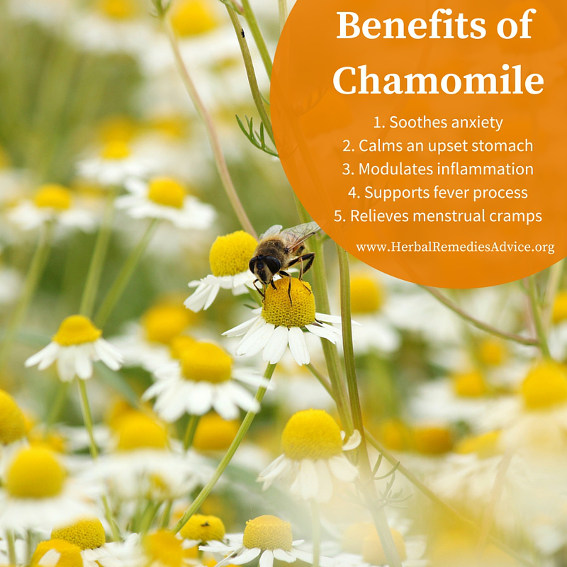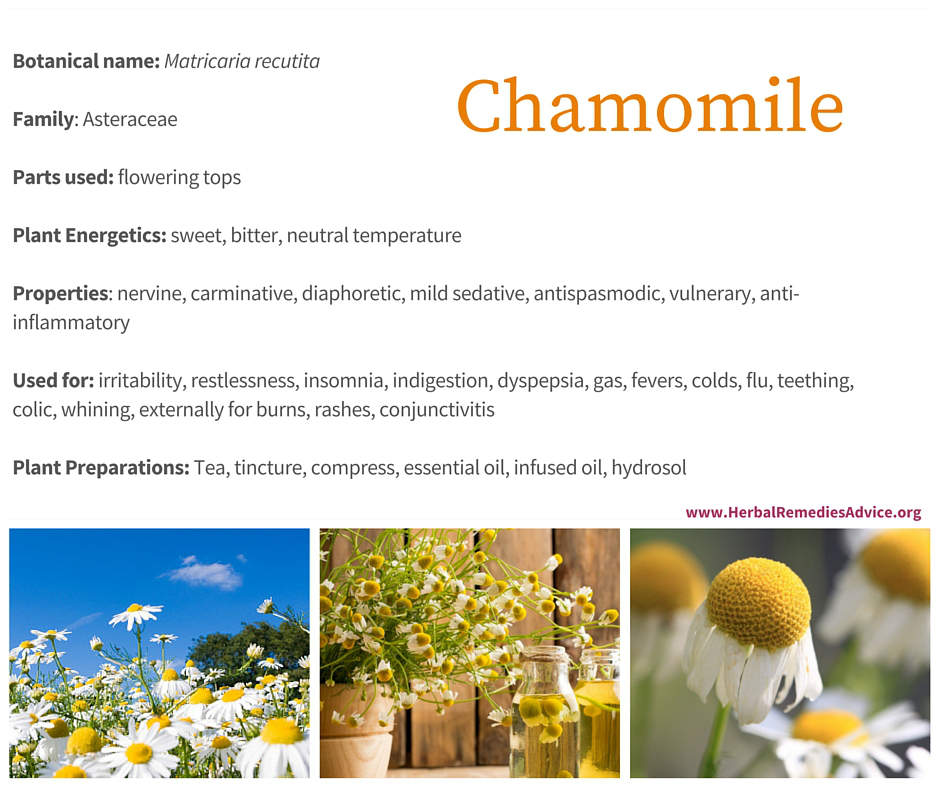Get weekly tips, recipes, and my Herbal Jumpstart e-course! Sign up for free today.
Chamomile Benefits
Share this! |
|
In this episode I’m sharing my top 6 chamomile benefits PLUS I’m sharing a completely underrated remedy: a chamomile oil recipe.
Chamomile, or Matricaria chamomilla, is one of our most powerful medicinal herbs, yet it’s gentle enough for most people to use. Chamomile seemingly does a thousand and one different things, from soothing the nervous system, relieving muscle tension, and addressing cold and flu symptoms, to promoting digestion and modulating inflammation. That’s a lot of amazing benefits from one little plant!
Speaking of inflammation, if YOU’RE concerned with chronic inflammation and the many ways this can show up in our bodies, like heart disease, cancer, type 2 diabetes, chronic pain, and more, then you’ll definitely want to check out my free, on-demand training:
How to Use Herbs to Transform Your Health to get More Energy & Vitality – Without Expensive Supplements or a Restrictive Elimination Diet. ►►► http://herb-training.com
Getting back to chamomile specifically, the chamomile infused oil recipe I’m sharing will give you a luxurious way to support your skin and promote rest. (Who couldn’t use more of that?)
After listening in to this episode, you’ll know:
► The key to working with chamomile to promote a good night’s sleep
► What types of pain chamomile can help to relieve
► What makes chamomile such a standout herb for supporting digestion
► How chamomile can benefit children
► and more…
As an herbal teacher, my success is seeing your success, so I love supporting you along the way! Be sure to download your free printable recipe card to get all the details on how to make your own high-quality and potent chamomile oil. I’m also sharing a beautifully illustrated chamomile e-book to give you an easy way to keep all the information I share in the video organized.
One of the best ways to retain and fully understand something you’ve just learned is to share it in your own words. I’m excited to hear YOUR herbal thoughts about chamomile plant benefits and this chamomile oil recipe in the comments at the bottom of this page!
-- TIMESTAMPS --
- 00:00 - Introduction to chamomile (Matricaria chamomilla)
- 04:33 - Chamomile energetics
- 05:47 - Chamomile benefits for the nervous system
- 07:32 - Chamomile benefits for relieving cramps and pain
- 09:01 - Chamomile benefits for cold and flu symptoms
- 10:03 - Chamomile benefits for improved digestion
- 11:50 - Chamomile benefits to modulate inflammation
- 14:31 - Chamomile benefits for children
- 15:29 - How to identify chamomile
- 16:00 - How to prepare chamomile
- 17:46 - Why make your own chamomile infused herbal oil?
- 18:47 - How to make chamomile oil
- 23:43 - Herbal tidbit
Download Your Recipe Card and Ebook!
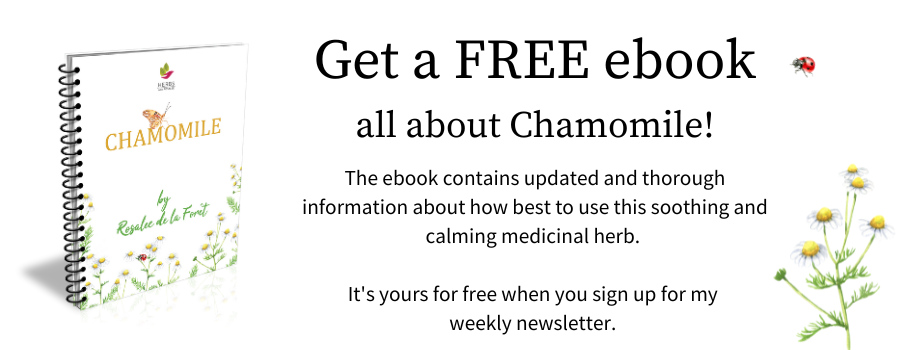
l
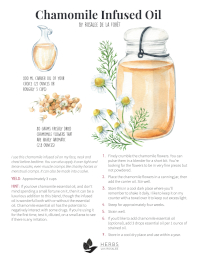
Transcript of the Chamomile Recipe Video
Many people are familiar with chamomile, but few know just how many amazing plant benefits there are in this little plant! Chamomile, or Matricaria chamomilla, is one of our most powerfully medicinally herbs, yet it’s gentle enough for most people to use. In this episode I’m sharing my top 6 chamomile benefits and showing you how to make a chamomile oil recipe. This chamomile infused oil recipe is a luxurious way to support your skin and promote rest. More on that soon!
For many years I basically ignored chamomile. Sure, I thought it was great for children or a nice tasting after-dinner drink, but when it came to serious herbal medicine, one would obviously look beyond chamomile.
However, I was completely wrong about chamomile and it has become one of my favorite and most used herbs.
Over many years of working with chamomile what I learned is that to get the most chamomile benefits you need to know how to prepare it for any given situation.
I also came to appreciate the advice of my friend and herbalist jim mcdonald, who points out that chamomile teaches us that “gentle does not mean weak.”
First, let’s make sure we’re talking about the same plant.
Chamomile has the genus and species name of Matricaria chamomilla. This chamomile used to have a different botanical name, Matricaria recutita, but is now officially Matricaria chamomilla. It’s sometimes called commonly called German chamomile.
The word chamomile is derived from words meaning earth and apple. In Spanish it is commonly called manzanilla, which means little apple.
There’s another plant that is also commonly referred to as chamomile.
This is Roman chamomile or Chamaemelum nobile. This is an entirely different plant than the one I’m sharing about today — with its own gifts and uses. If you ever get the chance to compare the two in scent and taste I highly recommend it.
And finally there’s a common weed, often called pineapple weed or Matricaria discoidea.
This plant loves to grow in hard packed driveways. It’s more closely related to Matricaria chamomilla and also smells and tastes very similar. I use the two interchangeably although it’s hard to find pineapple weed in non-toxic areas that are safe for harvesting.
Chamomile has been loved and revered by people for thousands of years…actually make that tens of thousands of years. Excavations at Jacob’s Bridge, an archeological site in Israel, reveal that Paleolithic humans were consuming chamomile as early as 49,000 years ago!1
There’s so much to know about chamomile and this episode is packed with chamomile benefits information! If you’d like to keep this information organized, I’ve made it easy for you.
Do you have experience with chamomile benefits? I’d love to hear about it in the comments at the bottom of this page. Your comments mean a lot to me! I love cultivating a community of kind-hearted plant-loving folks! Plus, it’s always interesting and insightful to hear the experiences of plant lovers out there. Your suggestion may also help others!
Okay, let’s dive in..
Chamomile Herb Energetics
Chamomile is high in aromatic essential oils while also having strong bitter principles (especially with longer steeping times). Many herbalists consider it warming to the digestion, yet it is also used as a relaxing diaphoretic (which is cooling) in support of the fever process. Like many plants chamomile defies classification, but with nuanced understanding we can effectively match this herb to the person and the situation.
If you’re new to the concepts of herbal energetics and understanding if a plant or a condition is hot or cold or damp or dry then I highly recommend my free Herbal Jumpstart Course.
This short video course takes you through the ins and outs of herbal energetics and by the time you finish you’ll have increased your herbal knowledge 10 fold.
This course is entirely free to everyone who joins my herbal newsletter community. In addition to getting the free Herbal Jumpstart Course you’ll also hear from me every Wednesday with my best herbal tips and recipes.
Tired of herbal overwhelm?
I got you!
I’ll send you clear, trusted tips and recipes—right to your inbox each week.
I look forward to welcoming you to our herbal community! Know that your information is safely hidden behind a patch of stinging nettle. I never sell your information and you can easily unsubscribe at any time.
As promised, I’m going to share my top 6 chamomile benefits!
Chamomile Benefits for the Nervous System
The first chamomile benefit is for supporting your nervous system to ease stress, anxiety and to promote calm.
Drinking a strong cup of chamomile tea is like getting a warm and reassuring embrace from a loved one. About halfway through a cup of chamomile tea, I notice my shoulders relaxing, my breath deepening, and my entire body unwinding.
Move over apples; in today’s stress-filled world, a cup of chamomile tea a day could be what keeps the doctor away.
For centuries herbalists have used chamomile to soothe the nervous system of both children and adults. A common saying is that chamomile is indicated for whining children or adults acting like whining children. It can also be taken at night to promote sleep. I’ve found that dosage is key here: the more you use, the more profound the results.
Researchers have taken an interest in chamomile and have conducted several human clinical trials to evaluate its ability to address both depression and anxiety.
In an exploratory study, researchers found that chamomile, even at a relatively small dose (220 mg), was more effective than placebo in relieving both depression and anxiety.2
Another clinical study found that chamomile relieved mild to moderate anxiety in people diagnosed with general anxiety disorder.3
I prefer chamomile for anxiety and pent-up nervous system energy (rather than low or depressive energy). It’s a relaxing nervine, meaning it decreases nervous system tension and helps the body switch to a more parasympathetic nervous system function.
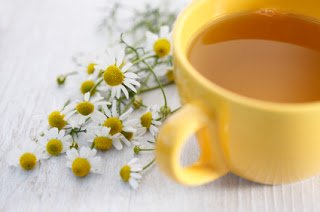
Chamomile Benefits for Relieving Cramps and Pain
The second chamomile benefit is for relaxing Muscle Tension to relieve Cramps and Pain.
As chamomile relaxes our nervous system it also relaxes the stress we hold in our muscles.
I reach for Matricaria chamomilla whenever there is muscle tension related to stress or simply muscle tension leading to pain. I’ve seen it relieve severe menstrual cramps, as well as headaches that are accompanied by excess tension in the upper back and neck. Since pain can often be accompanied by emotional distress, chamomile brings welcome relief on many levels.
In one clinical study, non-steroidal anti-inflammatory drugs (NSAIDs) were compared with chamomile in women with PMS. After two months, those using chamomile had a reduction in pain similar to that of the women using the NSAIDs, and those using the chamomile also had significantly fewer emotional symptoms.4
Another study looked at topical chamomile for carpal tunnel syndrome pain. In this pilot study the researchers concluded that “Chamomile oil improved symptomatic and functional status of patients with severe carpal tunnel syndrome.”5
For relieving muscle tension and pain chamomile can be taken internally as a tea, tincture, or glycerite. It can also be used externally on the affected area as an infused oil - I’ll be sharing my recipe for this underrated preparation in just a bit.
Chamomile Benefits for Cold and Flu Symptoms
The third chamomile benefit is for addressing Cold and Flu Symptoms.
Chamomile is my favorite herb for fevers accompanied by aches and pains.
Chamomile supports the fever process but it doesn’t artificially lower a person’s body temperature. Instead chamomile relaxes tension and has a relaxing diaphoretic effect, allowing excess heat in the body to escape through the skin. Taken as a really strong warm tea it can also be sedating, helping the patient to rest. The specific indications for chamomile for a fever is when the person feels hot, is irritable, has aches and pains possibly including a headache, and just wants to rest and sleep it off.
I’ve also seen chamomile tincture work well as an antispasmodic for those dry, hacking coughs that can often show up at the end of an illness. I like to accompany chamomile with moistening teas such as marshmallow or violet for these sorts of dry coughs.
Chamomile Benefits for Digestion
The Fourth chamomile benefit is for digestion.
Long used as a delicious after dinner drink, chamomile is a wonderful herb for digestion. It has both bitter and aromatic flavors that encourage digestive function, including the breakdown of fats.
If there is anxiety or tension interfering with digestion, chamomile again offers relief on many levels in that it both supports digestion while also helping you shift to a more relaxed state so you can better digest your foods.
Chamomile modulates inflammation and can be used for a myriad of inflammatory digestive complaints.
A 2023 in vitro study showed that probiotics, combined with chamomile, helped to maintain a healthy gut and therefore may be helpful for those with Irritable Bowel Syndrome.6
A 2016 study found that 1 gram of encapsulated chamomile per day significantly decreased the frequency of vomiting in women undergoing chemotherapy for breast cancer as compared to placebo.7 (It was shown to be as effective as ginger in reducing vomiting, although ginger decreased the frequency of nausea better than chamomile.)
A combination of chamomile and flaxseed has also been shown to be helpful for those suffering with dry mouth. When you don’t have enough saliva in your mouth it makes it hard to both chew and swallow food. Dry mouth is unfortunately very common in the elderly. In a 2017 clinical trial people who were taking the combination of chamomile and flaxseed had a greater relief of dry mouth symptoms than the conventional substitute.8
Chamomile Benefits to Modulate Inflammation
Whether you are new to my podcast and YouTube channel or you’ve been following me for awhile you’ll know that chronic inflammation is something I’m really passionate about.
Chronic inflammation is the root cause of many chronic diseases like cancer, heart disease, type 2 diabetes, many digestive complaints and ongoing pain.
Medicinal plants are phenomenal at addressing chronic inflammation! And chamomile is a great example of this.
Chamomile can be used externally as a poultice, fomentation, bath, or liniment to help calm inflammatory responses.
Think of it for rashes, burns, or even bleeding gums and oral mucositis.9,10
One interesting study compared the topical use of chamomile compresses with hydrocortisone cream for relieving itching and discomfort associated with skin lesions in people who have stomas (which is a surgically created opening in the abdomen that allows stool or urine to exit the body).
In this study, participants were either given a 1 percent hydrocortisone cream or chamomile compresses twice a day. Those using the compresses had a significantly faster healing time as well as a considerable decrease in pain and itching compared with those using the steroid cream. The researchers also pointed out that using chamomile instead of the steroid cream prevents serious side effects associated with topical steroid use, such as thinning of the skin.11
As I mentioned earlier, chronic inflammation is a major underlying factor of Type 2 diabetes.
Chamomile has also been demonstrated to relieve inflammation systemically in patients aged 30-64 with type 2 diabetes.
In this study, 32 men and women, who had type 2 diabetes drank chamomile tea 3 grams, 3 times per day immediately after meals. At the same time, 32 other men and women with type 2 diabetes drank the equivalent amount of water. After 8 weeks, those drinking chamomile had better glycemic control and increased antioxidant capacity.12
If you’re concerned with chronic inflammation and the many ways this can show up in our bodies, like heart disease, cancer, type 2 diabetes, chronic pain, and more, then you’ll definitely want to check out my free training: How to Use Herbs to Transform Your Health to get More Energy & Vitality – Without Expensive Supplements or a Restrictive Elimination Diet.
You can access this free training by visiting herb-training.com
Chamomile Benefits for Children
The 6th chamomile benefit is for children.
If I had to choose only one herb for children, it would probably be chamomile. It soothes the nervous system, supports the body during a cold or flu (common in children), and it tastes pretty darn good. It is commonly used, along with fennel, for infant colic, as well as to relieve pain and discomfort during teething.
Chamomile has also been shown, in partnership with apple pectin, to relieve acute diarrhea in children aged six months to six years.13
Chamomile can be used externally to clear up conjunctivitis (“pink eye”). I’ve seen that work with my own eyes!
In his book, Wild Medicine Solution, Guido Masé writes, “As I was growing up, there was always a cold and somewhat sweetened bottle of chamomile tea in the fridge.” What a great way to have the benefits of chamomile readily available for children.
How to Identify Chamomile
Chamomile is a delicate-looking plant in the Asteraceae family. As mentioned its botanical name is Matricaria chamomilla.
It has small daisy like flowers with white ray petals and yellow disk flowers. The flowers measure about 1/2 inch in diameter and are pleasantly aromatic.
The flowers grow on spindly stems that can form a dense mat. The roots are shallow.
The leaves are bi- to tripinnate.
How to Prepare Chamomile
Chamomile is commonly used in a variety of different preparations. But before I share about these I want to highlight that a small number of people are allergic or sensitive to plants in the Asteraceae family. These people should avoid chamomile or approach it with caution.
Of course chamomile is famous as a tea. And since it’s my favorite tea I’m doing a whole video about Chamomile Tea Side Effects and Benefits + I’m sharing my favorite Chamomile Tea Recipes. So look out for that.
Chamomile can also be used as a tincture or alcohol extract. This is my preferred method when I’m traveling or away from home, and for nighttime use for insomnia, pain, or nighttime spasmodic coughing.
Chamomile can be used in foods. It makes a nice syrup and I often include it when making popsicles.
Chamomile can be used externally: It can be infused into oil, as a poultice or fomentation, as an herbal bath, as a diluted essential oil, or as a liniment.
Chamomile essential oil is a beautiful product that turns a deep blue color. It has many benefits but also has the downside of being really expensive. That’s because it takes an amazing amount of chamomile in order to produce a small amount of the essential oil.
The essential oil of chamomile is basically concentrating super specific constituents within chamomile. Which has its pros and cons. Don’t get me wrong, it’s wonderful. BUT, you can get a more holistic preparation of chamomile simply by infusing the flowers into an oil.
This preparation is easy to make at home, a lot cheaper than the essential oil, and is more sustainable.
I love chamomile infused oil. I use it on my face, neck and chest before bedtime. You can use it over tight and tense muscles, even muscle cramps like charley horses or menstrual cramps.
It also modulates inflammation and can be part of a protocol to address inflammatory skin conditions.
I started making this infused oil a few years ago and gave it to my friend who had small children. It became their nightly ritual to rub on the oil just before bed. This year my friend, who’s also a farmer, grew an entire row of chamomile so that she could make enough oil for the whole family for an entire year. I’m telling you, this stuff is amazing.
I like to use this as a face oil, but you can also use this in a salve recipe.
To make this you only need two ingredients:
- freshly dried chamomile flowers that are highly aromatic
- a carrier oil of your choice
If using your chamomile oil in salves, olive oil is an ideal carrier oil because it is shelf stable and affordable. If using it as a face oil, cream, or body butter, then a lighter oil such as jojoba or apricot kernel oil is a better choice.
If you love chamomile essential oil, and don’t mind spending a small fortune on it, then it can be a luxurious addition to this blend, though the infused oil is wonderful both with or without the essential oil. Chamomile essential oil has the potential to negatively interact with some drugs. If you’re using it for the first time, test it, diluted, on a small area to see if there is any irritation.
Here’s how to make the infused oil.
1. Finely crumble the chamomile flowers. You can pulse them in a blender for a short bit. You’re looking for flowers that are in very fine pieces but not powdered.
2. Fill a jar halfway with the chamomile flowers.
3. Fill the jar the rest of the way with the carrier oil. Stir well. Add more oil if necessary.
4. Store this in a cool dark place where you’ll remember to shake it daily. I like to keep it on my counter with a towel over it to keep out excess light.
5. Steep for approximately four weeks.
6. Strain well.
7. If using the optional chamomile essential oil, add 3 drops essential oil per 1 ounce of strained oil.
8. Store in a cool dry place and use within a year.
Okay, I’ve shared a lot of chamomile plant benefits with you so I’ve got two downloadables for you! As an herbal teacher, my success is seeing your success, so I love supporting you along the way!
The first is your free printable recipe card for this chamomile oil recipe, which you can download above this transcript!
The second is a chamomile ebook which is beautifully illustrated and contains the information I’ve just shared.

If you enjoyed this video on chamomile benefits and this chamomile oil recipe and you value trusted herbal information, then I hope you’ll stick around! The best way to get started is to subscribe on YouTube and your favorite podcast app.
One of the best ways to retain and fully understand something you’ve just learned is to share it in your own words. With that in mind I invite you to share your takeaways with me and the entire Herbs with Rosalee community. You can leave comments at the bottom of this page, or simply hit reply to my Wednesday email. I read every comment that comes in and I’m excited to hear your herbal thoughts about chamomile plant benefits and this chamomile oil recipe.
Okay, you’ve lasted to the very end of the show which means you get a gold star and this herbal tidbit…
Chamomile is a gentle plant, but that doesn’t mean it’s weak!
As shared, the botanical name for chamomile is Matricaria chamomilla.
The genus Matricaria is derived from the word mother. Some people say that this is because chamomile is wonderful for mothers. Others say that drinking chamomile is like getting a hug from your mother.
I think it could also point to the way chamomile is like a mother who has the ability to be gentle and sweet, but can be strong and powerful when needed.
Like a mama bear.
Chamomile is not only gentle and powerful, it seemingly does a thousand and one different things, from soothing the nervous system, relieving muscle tension, and addressing cold and flu symptoms, to promoting digestion and modulating inflammation. Best of all, regularly reaching for chamomile preparations can bring some comforting sunshine to your life.
Citations for Chamomile Benefits
Click to show/hide.
Rosalee is an herbalist and author of the bestselling book Alchemy of Herbs: Transform Everyday Ingredients Into Foods & Remedies That Healand co-author of the bestselling book Wild Remedies: How to Forage Healing Foods and Craft Your Own Herbal Medicine. She's a registered herbalist with the American Herbalist Guild and has taught thousands of students through her online courses. Read about how Rosalee went from having a terminal illness to being a bestselling author in her full story here.
